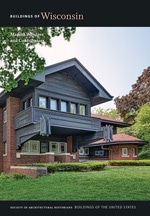
St. Wenceslaus is a rare example of the log churches that immigrants built in the early years of Wisconsin’s settlement. Immigrants from Bohemia and present-day Germany who farmed the “islands” (high ground) of Blue Joint Marsh built this small gabled building of tamarack logs. Within a few years, they weatherproofed the exterior with board-and-batten cladding, perhaps adding the square two-stage belfry at that time. The church is plain outside and inside. On the interior, the logs remain apparent through a half-inch coating of lime plaster. John Fiedler, a local craftsman, built the pine pews, cutting them with a foliated profile. The only embellishments that relieve the austerity of the interior space are the artwork over the simple altar, including the image of St. Wenceslaus, patron of Bohemia. Wrought-iron candleholders under each station of the cross remind us that candles and oil lamps once provided the only sources of illumination, and a small iron stove with its extended stovepipe, standing in the aisle, gave the only heat. Regular services ceased in 1891, when the parishioners joined St. Joseph’s congregation in Waterloo.

